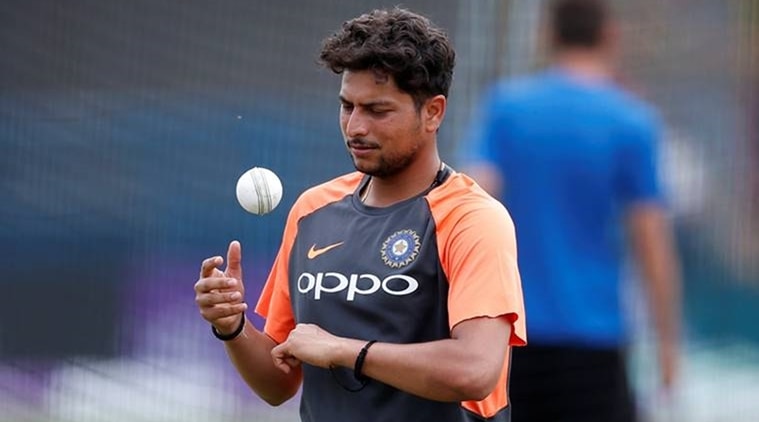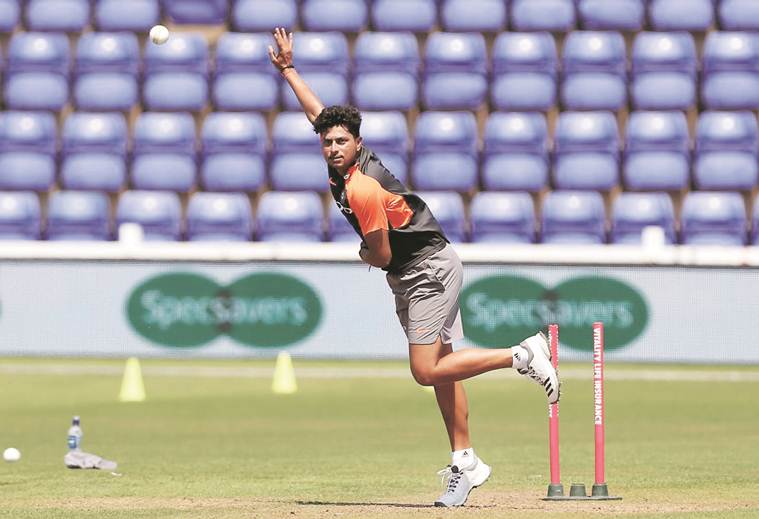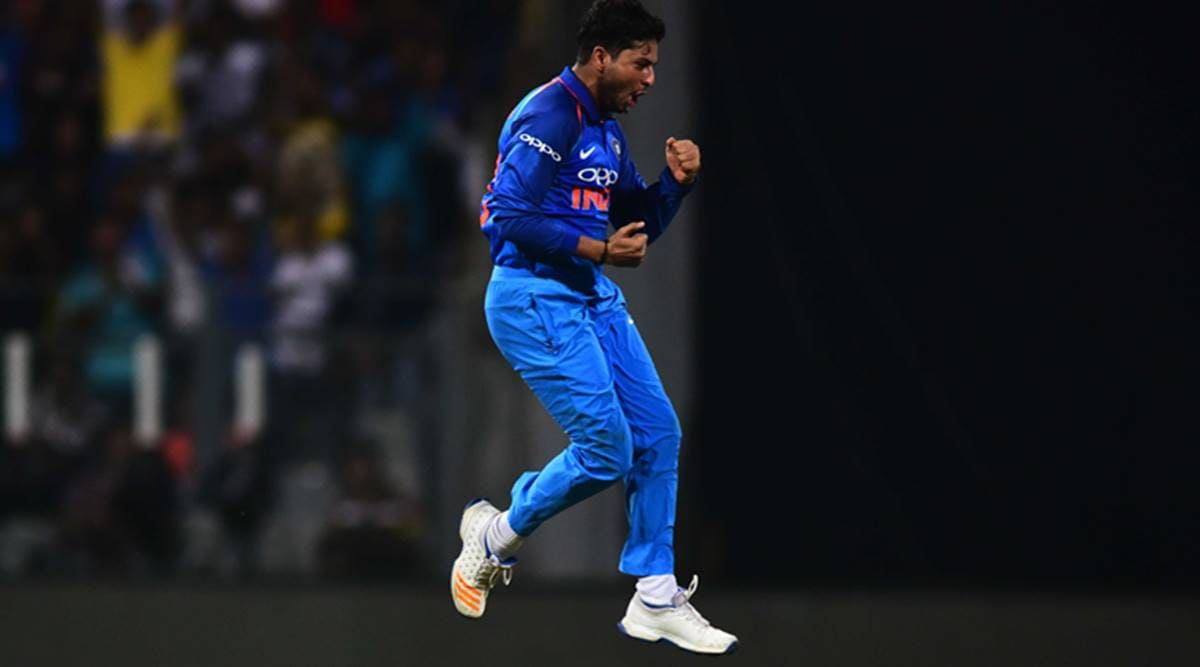From Shane Warne and Brad Hogg to MS Dhoni and Yuzvendra Chahal, Kuldeep Yadav has had an assortment of teachers to look up to. Sandip G on the chinaman who after his fiver at Sydney is being called India’s most exciting and fastest improving all-format bowler.
After sitting out the first three Tests in Australia, Kuldeep Yadav took a five-for in Sydney to burnish his credentials. (Source: PTI)
“Bhaiya, hawa kis side ki hai?” R Ashwin was puzzled by this query from Kuldeep Yadav, who had run out with refreshments during the drinks break of the opening India-Australia Test last year.
Kuldeep wasn’t playing that game but he was chalking out the entrapment script and thus factoring in the variables like breeze. “It’s the way I always watch games when I’m not playing. Physically I might not be there, but mentally I am there, bowling uninterrupted for the entire day, fully switched on and aware,” he says. It’s been more than two months since that Test but those memories are fresh in the mind of the chinaman bowler, who is now preparing for the ODI series against Australia.
“For a spinner, the mind is the most important thing, it should never be idle, but always fresh, always thinking. So whoever is actually bowling in the middle, be it Jasprit (Bumrah) or Ashwin bhai, I just imagine myself to be bowling at the batsmen, the things I would do, how I would look to get him out and how he would try to play me. And then I try to figure out the plans of Jasprit and Ashwin, who are very different bowlers.”
Australian skipper Tim Paine would attest. During the final Test in Sydney, when Kuldeep finally got a chance to be in playing XI, he was ready. Those long hours of strategising while in the dressing room had paid off. Kuldeep had Paine’s stumps disarrayed by a delivery that turned like a top. New age broadcasting tools used to measure the turn of the ball showed a staggering reading: 9.9 degree. “Bahut maza aya uska wicket le ke,” says Kuldeep, giggling with school-boyish joy. It wasn’t the turn that excited him, but the precise execution of a plan hatched long ago. “It was exactly how I had dismissed him in Adelaide,” he says. In his mind.
Not just the ball, but the whole build-up was rehearsed and nuanced to perfection several times. “I noticed that he liked to play Ash bhai on the back-foot, the good length balls. Slightly fuller ones, he would compulsively go for the drives, leaving a lot of space between the bat and the body. So when I slip in a full-length delivery after a few good-length ones, he would lunge for the drive. If I can beat him in the air, I can get him bowled.”

Kuldeep Yadav. (Source: Reuters/File)
So every time, he came to bat, in Adelaide, Perth and Melbourne, he would imagine setting him up with that delivery. And when the opportunity knocked in Sydney, the dream played out as a reality. All it required was seven deliveries — the seventh, a classical chinaman delivery, one that hung for an eternity in the air, then dipped alarmingly and barged through the enormous space between his bat and pad. Then that’s the visual trickery of flight and dip.
Happy as Kuldeep was, he also felt a touch deficient, because Paine fell for the bait all too easily, just when the kick of out-thinking a batsman was kicking in. “The more you work on dismissing a batsman, the happier you get. Of course, you don’t want to dismiss him after he plunders hundred runs off your bowling, but the biggest thrill of spin bowling is about out-thinking a quality batsman. Yeh dimag wala khel hai!” he chuckles.

By his own admission, he doesn’t rely too much in video footages. The game that he isn’t playing is the game that he’s actually playing, “So that if I’m coming up against a new batsman, I know I have bowled at him several times in the mind and I know exactly what I need to get him out.”
EXPLAINED
Master of disguise
A batsman would decipher variations from the spinner’s hand, watching his wrist and the seam position. But Kuldeep can, with the same release, make the ball break in opposite directions. Here’s how he does it. Scrambled seam: Batsmen assess whether it’s a chinaman or wrong’un by watching the seam. Left-arm wrist spinners bowl seam up for their stock deliveries, the one that’s turning in, while resorting to scrambled seam for the googly. It’s mostly because the googly is usually released from the back of the hand. So a cross-seam gives you better control. But Kuldeep can do both with a scrambled seam. Side-of-the-hand googly: Usually, the chinaman will come from the side of the hand and the wrong’un from the back of the hand. Again, it’s for a better grip — the top joints of the index and middle fingers is across the seam, with the ball resting between a bent third finger and the thumb. But Kuldeep can propel both from side of the hand, leaving the batsman with only two options — to wait for the ball to turn, a dangerous proposition with the amount of turn he can generate, or smother it on the half-volley. The latter ploy is equally dangerous with his mastery of flight and dip. No exaggerated movement: Another way batsmen read a spinner is by watching the exertion of wrists,the snap at release gets snappier. Bowlers turn their wrists around further when they bowl the googlies to get that whip, but not with Kuldeep, whose wrist movements have subtle differences. The reason is when he bowls the googlies, he bowls with just one finger on top of the ball.
If Ashwin nailed a right-handed batsman with his doosra, Kuldeep would be thinking from a different tangent. “My wrong’un spins a lot, so the batsman, if he picks it, can leave or even cut, while Ash bhai’s doosra turns just that much to take his outside edge. I would rather try a flipper and get him lbw,” he says.

The inexhaustible enthusiasm to learn different facets of his craft, despite the spectacular success, set him apart on the road to greatness. (Reuters file photo)
The first thing Brad Hogg noticed about Kuldeep was his beaming smile. How can he smile so radiantly, he once asked him. Kuldeep says Rohit Sharma, one of his closest friends in the team, always queries about the secret of his smile. He replied: “I tell him I’m always happy, I don’t harbour any negative thoughts and I like to spread positive energy. I have long figured out that being glum doesn’t help anybody, neither you or your teammate.”
It’s also a facade, he says, that hides his fears and doubts. “I’m somebody who likes to feel pressure, so I put myself under pressure before matches. Before every match, I imagine that I’m making debut, getting hammered by the batsman or not getting any overs to bowl. Pressure always perks me up, you are always focused and aware, the mind hardly drifts. You can’t sit back on the five-for you’d picked in the last match,” he says. But at the same time, he can’t show pressure. So the smile.
The only time he couldn’t muster the smile to hide his inner turmoil was soon after the India-England Lord’s Test last summer. He was in the playing XI of a Test after nearly a year and there was pressure on him to do well. The conditions weren’t conducive for spin bowling. Rain and a chilling breeze adding to the woes of the wrist spinner.
“I could rarely smile. I saw the world crumbling in front of me, but when I look back now, I realise that everything in life has a purpose. The Lord’s Test was an eye-opener, a reality check. I realised I needed to work harder and prepare better so that I wouldn’t repeat the mistakes,” he says.

Kuldeep Yadav Kuldeep went for 44 runs from his 9 ineffective overs. His first away Test didn’t go the way he had planned. There were a few regrets, one of them was not getting enough overs with the Duke’s balls. So, two days after he returned from England, he brought a box of Kookaburra Test balls — which are used in Australia — and began practising with those. “Much of a spinner’s confidence is about how he grips the ball. You need to get really familiar with it. So whenever I got time I would prepare with the Test balls so that I became as comfortable with it as I am with the SGs. Maybe, it was easier because I have played a lot of limited-over games with the Kookaburra, though the ones used for the Tests are slightly different,” he recollects.
Prosperity in India A games and Tests against the West Indies resuscitated his morale, the smile reclaimed the watts, but he was hurting deep inside him. He wanted to file a rejoinder to the Lord’s disaster at the earliest. He wasn’t worried about lazy talks of his mystery weaning. “What mystery? Sab bakwas hai. I am using the same weapons like Ash bhai — flight, drip, drift and turn — only that I’m a wrist spinner and he’s finger spinner.”
In that sense, he is a rare bird than a mysterious, imaginary unicorn, and his craft promises longer longevity than a mystery-spin peddler. The latter’s career has a gimmicky, predictable arc — a sensational entry, fancy deliveries and an absolute disappearance in the subsequent months. Like Ajanta Mendis, who once had the world ’s most fabled middle-order dancing like puppets to the tunes of his carrom-ball flicking index finger, only to slip down the stream of obscurity. Wrist spin, elusive as it may be, is the among the oldest tricks in cricket.
Not to drift from the main narrative, the Kuldeep that landed in Australia was a different man, still smiling, but a setback-survivor. In Sydney, he redeemed himself with a five-for (5/99). “Even before the series, I had a hunch that I would play in Sydney. So I would just visualise bowling there and getting those wickets.” He felt a sense of deja vu. And it’s the broadest he has ever smiled and the loudest he had ever laughed. And a smile he says he would struggle to replicate in the future.
***
As Shane Warne strode into the Adelaide Oval for his bit of television-punditry, Kuldeep scampered from the India dressing room to meet him. Catching his breath, he hugged his idol and struck a conversation. The Aussie legend was busy, had to sprint back to the commentary box for his shift, but he couldn’t disappoint one of his wrist-spin brethren either. So he struck a deal. They will meet every day before the match began. He knew he couldn’t oblige every day, but on as many days as possible.
So the next day, they met in the tunnel that connected the dressing room and the ground. Kuldeep didn’t waste time. “I wanted to ask him as many as questions about wrist-spin as I could.” The first thing he asked him about was the fizz Warne purchased from the surface. “I could get fizz from dry surfaces, but he would on any surface,” he says, recalling his dilemma.
“Warne came with an instant reply, ‘I think it’s because your leading arm is going straight, whereas it should go away. It’s going straight because your shoulder is looking down when you’re releasing the ball.’ Then he demonstrated the action, left-handed. I wondered whether he can bowl wrist spin with both arms. He also advised me to be patient with it, and gradually weave the tweak into my action. I am still working on it.”
The inexhaustible enthusiasm to learn different facets of his craft, despite the spectacular success, set him apart on the road to greatness. In Adelaide, it was Warne, in Perth it was Hogg, with whom he shares almost a paternal bond.
“We met a few times in a cafe, where we discussed my ‘ball landing’. We have been working on it for a while. My knees tend to bend at release. Straighter knees, he believes, would help me get more flight. So we have been working on straightening my run-up.”
Other talks included the setting of the field — he told him to keep both the short-leg and silly point — the spots to bowl and the importance of mixing up the pace. “He asked me to pitch the chinaman closer to the off-stump, as you wouldn’t get as much turn as you would in the subcontinent. Also the flipper needed to be fuller as there’s more bounce on Australian surfaces,” he says, stressing the need to be “always a student of the game.”
From Warne and Hogg to MS Dhoni and best chum Yuzvendra Chahal, he has an assortment of teachers to look upto. Warne, he says, is enlightening, Hogg matter-of-fact, Dhoni hands-on and Chahal serious. Not to forget, as he always reminds, his childhood coach Kapil Pandey. He then nudges, laughing, and poses a rhetorical question: “But you should be good student to get the best out your teachers. Shouldn’t you?”
With the records he had racked up since the debut, there’s no doubting the diligence of this bright, disarmingly smiling student of Warne and Co.


